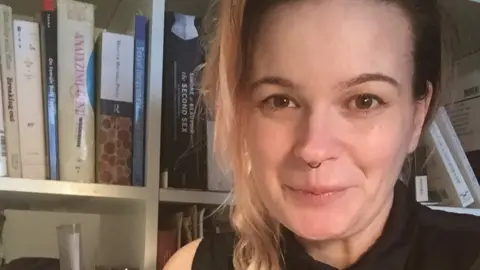100 Women: The 'right amount' of panic for women in public
 Getty Images
Getty ImagesHave you ever wondered how much time and energy women spend avoiding harassment from men? Dr Fiona Vera-Gray is a researcher from Durham University who has spent the last five years speaking to women about how they change their behaviour through fear of sexual harassment and assault. As part of this year's 100 Women Challenge, she explains how speaking about this can help to find a solution.
For the past five years I've been talking to women in the UK about their experiences of sexual harassment in public. Women from 18 to 68 have shared stories of men's intrusion, from being masturbated at during a food shop on a Sunday to being told to cheer up after just having had a miscarriage.
I remember the first time it happened to me. Walking to primary school with my best friend, flashed by a man who blocked our way. We knew even then to just keep walking, to not tell anyone, to laugh it off.
What about you? If you're a woman reading this, when is the first time that you remember interruption from an unknown man in public? Being told to cheer up, being stared at, a whistle, a car horn, a comment, followed, touched?
What about all the times you've thought… maybe? You think that man might be staring at you but you couldn't say for certain.
Don't want to be thought of as narcissistic. Don't want to be called paranoid. But maybe, you think, I'll just sit over here, get on the bus, do a quick scan, choose the seat closest to other women, or closest to the driver. Catch the next train, just to be safe.


What is 100 Women?
BBC 100 Women names 100 influential and inspirational women around the world every year. In 2017, we're challenging them to tackle four of the biggest problems facing women today - the glass ceiling, female illiteracy, harassment in public spaces and sexism in sport.
With your help, they'll be coming up with real-life solutions and we want you to get involved with your ideas. Find us on Facebook, Instagram and Twitter and use #100Women

Maybe, like Delilah, a black British woman in her early 20s who I interviewed, you stay away from wearing the colour red, to avoid standing out. Or like Shelley, a British Asian woman in her 30s, you've developed a death stare, looking tougher than you feel.
Maybe like Lucy, a white British woman in her late teens, you've pulled out your phone and made a fake call with your battery long dead. Or like Ginger, a white Latvian woman in her 20s, you've kept headphones in without playing music so you can hear what they think you can't.
And it's not just the women I've spoken with. One of the largest studies conducted on sexual harassment in Europe found that almost half of the 42,000 women surveyed had restricted their freedom of movement based on the fear of gender-based violence.
 Getty Images
Getty ImagesDespite how common it is, or perhaps because of it, we rarely even think about the routine choices and changes we make to maintain a sense safety.
Liz Kelly, one of the world's leading sociologists on violence against women, coined the term "safety work", to describe the habitual strategies that women develop in response to their experiences in public. We perform safety work often without thinking, it becomes part of our habits, or "common-sense".
Whilst the forms and frequencies of men's harassment of women may be different across the world, the work that women perform in order to limit it is constant. Constant. And that work is limiting our freedom.
 Handout
HandoutThe vast majority of this work is pre-emptive, we often can't even know if what we are experiencing as intrusive is intrusive unless it starts to escalate: he speeds up and crosses the street when you do, he moves from staring to touching.
But as this is the very thing safety work is designed to disrupt, success becomes the absence of what might have happened.
After all, we know that it doesn't, it simply can't, always work, and those are the only times we can count. So women are stuck, made responsible for preventing harassment at the same time as unable to know when we've been effective.
All of this was encapsulated in the words of one woman I spoke to in London, Katie-Lou. What women are daily being asked to have is the "right amount" of panic.
"It's conflicting messages isn't it? It's take care of yourself but then if you imagine that someone is maybe a danger you're being a silly woman. You have to do just the right amount of panicking don't you?"
Put simply, there is no "right amount" of panic, there's only ever too much or not enough. And with no way to know when we're getting it right, we've learnt to just keep quiet.
Trapped inside a Catch-22, giving up our freedom and getting blamed regardless, we change ourselves, subtly, slightly. Small decisions to limit the chance, habits that soon become hidden. So much work to feel safe. So much work that goes unnoticed.
But what if we did start to talk about the ways you trade your freedom to feel safer? Not only about the big decisions, but those little habits, almost unseen.
We've started to hear the range and extent of women's experiences of sexual harassment.
What would happen if we created a space to speak of our safety work in public? What would you say?
Dr Fiona Vera-Gray is a researcher at Durham Law School, specialising in violence against women. Her book The Right Amount of Panic: How women trade freedom for safety in public is due to be published by Policy Press in 2018.
